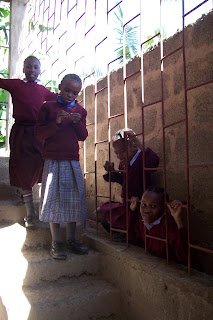A group of Umoja Arts teachers and staff made a trip to Zanzibar to hear the music of Saudi Za Busara, a well known world music festival that takes place on the island yearly.
We went by Dar Express (a 9 hour bus ride) and then took the ferry to Stone Town, one of the most famous and historically rich areas of the island (http://en.wikipedia.org/wiki/Stone_Town). When our ferry docked, the sun was nearly down. We made our way to a friend's apartment by walking along the beach, through the soccer games and swimmers.
(just after our ferry trip)
We eventually headed inland, through the narrow streets that turned and darkened. Disoriented and in awe, we climbed the stairs to the apartment and took a rest before heading out to take in the music of the evening.The festival was held in an old fort called...Old Fort! It was a surprisingly small audience, though the space was filled to the brim. The musicians performing as we arrived were from Senegal. They stopped for 15 minutes to pray between each song. They were very passionate about sharing their music and that made it all the more pleasurable to listen to.

This image made me think of my Dad and our summer trips to Michigan where some part of our time was dedicated to scoping out the boats in the Great Lakes. The big blue and white ship on the left is actually a vacant 'ghost' ship. Apparently it's been floating there for a few years now.
Here it was low tide, but we all decided to brave the sharp coral and urchins to swim in the light blue-green band that can be seen at the horizon. It was Fatma's birthday at this point. Unfortunately, within 5 minutes of her swim session she stepped on an urchin. She spent a large portion of the beach visit pulling sea the needles from the heels of her feet.
A lovely view of the indian ocean from our table of morning coffee...
Building in progress.
A view from the front row on the Dar Express. I had come down with malaria at this point, so the journey was a rough one. The Dar Express buses always display a name and some flashy designs along the sides. This particular bus was given the name 'Glory to God.' You might just be able to make out the lettering along the top of the giant window. Despite feeling achy and feverish, I managed to enjoy the sights as well as the four tribal themed movies presented by our 'Glory to God' hosts.















